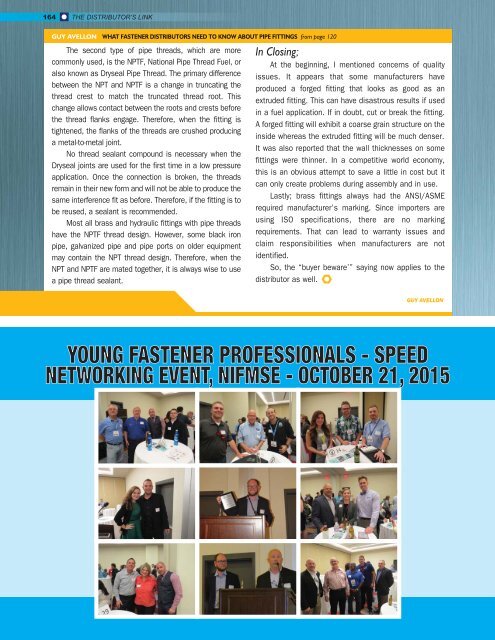WINTER 2016
Distributor's Link Magazine Winter Issue 2016 / Vol 39 No1
Distributor's Link Magazine Winter Issue 2016 / Vol 39 No1
Create successful ePaper yourself
Turn your PDF publications into a flip-book with our unique Google optimized e-Paper software.
164 THE DISTRIBUTOR’S LINK<br />
GUY AVELLON WHAT FASTENER DISTRIBUTORS NEED TO KNOW ABOUT PIPE FITTINGS from page 120<br />
The second type of pipe threads, which are more<br />
commonly used, is the NPTF, National Pipe Thread Fuel, or<br />
also known as Dryseal Pipe Thread. The primary difference<br />
between the NPT and NPTF is a change in truncating the<br />
thread crest to match the truncated thread root. This<br />
change allows contact between the roots and crests before<br />
the thread flanks engage. Therefore, when the fitting is<br />
tightened, the flanks of the threads are crushed producing<br />
a metal-to-metal joint.<br />
No thread sealant compound is necessary when the<br />
Dryseal joints are used for the first time in a low pressure<br />
application. Once the connection is broken, the threads<br />
remain in their new form and will not be able to produce the<br />
same interference fit as before. Therefore, if the fitting is to<br />
be reused, a sealant is recommended.<br />
Most all brass and hydraulic fittings with pipe threads<br />
have the NPTF thread design. However, some black iron<br />
pipe, galvanized pipe and pipe ports on older equipment<br />
may contain the NPT thread design. Therefore, when the<br />
NPT and NPTF are mated together, it is always wise to use<br />
a pipe thread sealant.<br />
In Closing;<br />
At the beginning, I mentioned concerns of quality<br />
issues. It appears that some manufacturers have<br />
produced a forged fitting that looks as good as an<br />
extruded fitting. This can have disastrous results if used<br />
in a fuel application. If in doubt, cut or break the fitting.<br />
A forged fitting will exhibit a coarse grain structure on the<br />
inside whereas the extruded fitting will be much denser.<br />
It was also reported that the wall thicknesses on some<br />
fittings were thinner. In a competitive world economy,<br />
this is an obvious attempt to save a little in cost but it<br />
can only create problems during assembly and in use.<br />
Lastly; brass fittings always had the ANSI/ASME<br />
required manufacturer’s marking. Since importers are<br />
using ISO specifications, there are no marking<br />
requirements. That can lead to warranty issues and<br />
claim responsibilities when manufacturers are not<br />
identified.<br />
So, the “buyer beware’” saying now applies to the<br />
distributor as well.<br />
GUY AVELLON<br />
YOUNG FASTENER PROFESSIONALS - SPEED<br />
NETWORKING EVENT, NIFMSE - OCTOBER 21, 2015

















